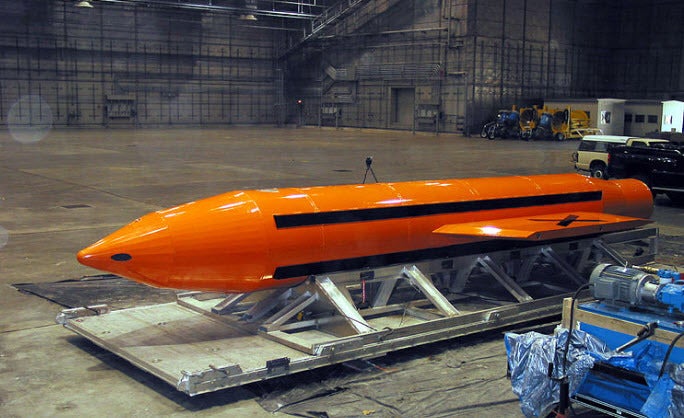
The United States military dropped its largest non-nuclear bomb, the GBU-43/B Massive Ordnance Air Blast Bomb (MOAB), nicknamed the “mother of all bombs,” on an ISIS cave and tunnel complex in the Achin District of the Nangarhar province, Afghanistan. The Achin District is the center of ISIS activity in Afghanistan. This was the first use in combat of the GBU-43/B Massive Ordnance Air Blast (MOAB).
Developed in 2003 by the Air Force Research Laboratory at a cost of $300 million, with each bomb costing $16 million, the United States Air Force MOAB is a 30-foot long, 21,600-pound, GPS-guided munition. Its enormous size requires an air force cargo plane, in this case the MC-130, to deliver it to its intended target. Although it carries only about 8 tons of explosives, the explosive mixture delivers a destructive impact equivalent of 11 tons of TNT.
How does the air force achieve this increase in destructive force?
There is little doubt the United States Department of Defense is likely using nanometals, such as nanoaluminum (alternately spelled nano-aluminum) mixed with TNT, to enhance the detonation properties of the MOAB. The use of nanoaluminum mixed with TNT was known to boost the explosive power of the TNT since the early 2000s. If true, this means that the largest known United States non-nuclear bomb is a nanoweapon. When most of us think about nanoweapons, we think small, essentially invisible weapons, like nanobots (i.e., tiny robots made using nanotechnology). That can often be the case. But, as defined in my recent book, Nanoweapons: A Growing Threat to Humanity (Potomac 2017), “Nanoweapons are any military technology that exploits the power of nanotechnology.” This means even the largest munition, such as the MOAB, is a nanoweapon if it uses nanotechnology.
This begs a question:Does the United States MOAB use nanotechnology? Let address this by looking at the explosive composition. The explosive is H6, which is a mixture of five ingredients (by weight):
- 44.0% RDX & nitrocellulose (RDX is a well know explosive, more powerful that TNT, often used with TNT and other explosives. Nitrocellulose is a propellant or low-order explosive, originally known as gun-cotton.)
- 29.5% TNT
- 21.0% powdered aluminum
- 5.0% paraffin wax as a phlegmatizing (i.e., stabilizing) agent.
- 0.5% calcium chloride (to absorb moisture and eliminate the production of gas)
Note, the TNT and powdered aluminum account for over half the explosive payload by weight. It is highly likely that the “powdered aluminum” is nanoaluminum, since nanoaluminum can enhance the destructive properties of TNT. This argues that H6 is a nano-enhanced explosive, making the MOAB a nanoweapon.
The United States GBU-43/B Massive Ordnance Air Blast Bomb (MOAB) was the largest non-nuclear bomb known until Russia detonated the Aviation Thermobaric Bomb of Increased Power, termed the “father of all bombs” (FOAB), in 2007. It is reportedly four times more destructive than the MOAB, even though it carries only 7 tons of explosives versus the 8 tons of the MOAB. Interestingly, the Russians claim to achieve the more destructive punch using nanotechnology.
Based on this, a reader might conclude that the Russians are ahead in nanotechnology and winning the race for the largest non-nuclear bomb. I think those conclusion would be premature. While it is true that the United States dropped its MOAB with an observable 11 ton TNT punch, it does not preclude that the United States has other non-nuclear bombs of even more destructive power. Recall in the 1990 gulf war, the United States used some munitions that dated back to the 1960s. However, the media coverage focused on the most advanced weapons, like stealth aircraft and smart bombs. Based on all available evidence and extensive research, I conclude the United States is the clear leader in nanotechnology, especially as it applies to weapons, which I factually demonstrated in my book Nanoweapons. Therefore, it is reasonable to believe the United States already has the capability to surpass Russia’s “father of all bombs.”
Neither the Russians nor the United States explain exactly how these highly destructive non-nuclear bombs actually work. However, based on the enormous amount of scientific evidence that nanoaluminum enhances the explosive properties of TNT, I think it is highly probable that nanotechnology is at the heart of the explosives used in both bombs. If true, both bombs qualify as nanoweapons.
This may lead you to a startling conclusion. Nanoweapons are not just small, nearly invisible weapons, but can be some of the largest weapons in a military’s arsenal. In weapons: Nanotechnology Inside = Nanoweapons.
Image: Courtesy of the United States Air Force
